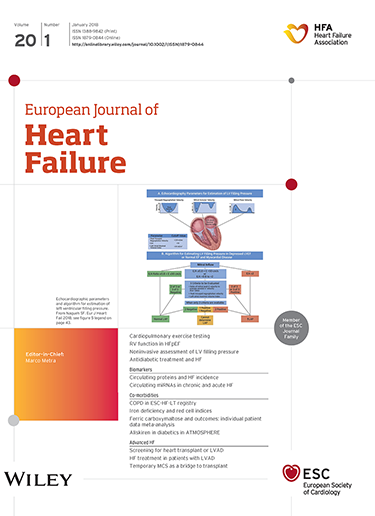Impact of canagliflozin on heart stress and outcomes: Pooled insights from CREDENCE and CANVAS.
IF 10.8
1区 医学
Q1 CARDIAC & CARDIOVASCULAR SYSTEMS
引用次数: 0
Abstract
AIMS In individuals with type 2 diabetes with cardio-renal disease but no known heart failure (HF), elevated N-terminal pro-B-type natriuretic peptide (NT-proBNP), a marker of heart stress, signals higher risk of HF and cardio-kidney complications. This analysis assesses canagliflozin impact on heart stress and outcomes using age-adjusted NT-proBNP thresholds from two major trials. METHODS AND RESULTS This analysis included 5281 participants from the CANVAS and CREDENCE trials without HF at baseline. NT-proBNP was measured at baseline and year 1, with heart stress defined using age-adjusted NT-proBNP thresholds. Outcomes included a primary composite (end-stage kidney disease, doubling of serum creatinine, kidney or cardiovascular death), kidney composite, HF hospitalization, cardiovascular death, all-cause death, and HF hospitalization or cardiovascular death composite. Multivariable Cox models assessed heart stress, outcomes, and canagliflozin effects. At baseline, 45% of participants had heart stress. Heart stress independently predicted increased risks for all outcomes, with the highest risks in those with persistent or rising NT-proBNP at baseline and year 1. Rising NT-proBNP by year 1 was associated with higher risk as well. Canagliflozin significantly reduced risks in individuals with heart stress, including the primary composite (hazard ratio [HR] 0.72, 95% confidence interval [CI] 0.62-0.84), kidney composite (HR 0.65, 95% CI 0.53-0.79), and HF hospitalization (HR 0.68, 95% CI 0.54-0.85). Benefits were less pronounced in those without heart stress. CONCLUSIONS Age-adjusted NT-proBNP thresholds effectively predict cardio-kidney events in at-risk type 2 diabetes individuals without HF. Canagliflozin offers strong cardiovascular and kidney protection, with the greatest benefits in those with heart stress, emphasizing the need for early identification and intervention. CLINICAL TRIAL REGISTRATIONS CANVAS (NCT01032629), CREDENCE (NCT02065791).卡格列净对心脏应激和预后的影响:来自CREDENCE和CANVAS的综合见解
2型糖尿病合并心肾疾病但没有心衰(HF)的个体,n端前b型利钠肽(NT-proBNP)升高,这是一种心脏应激标志物,表明心衰和心肾并发症的风险较高。本分析使用来自两项主要试验的年龄调整NT-proBNP阈值评估了卡格列净对心脏压力和结果的影响。方法和结果本分析纳入了基线时无HF的CANVAS和CREDENCE试验的5281名受试者。在基线和第一年测量NT-proBNP,使用年龄调整的NT-proBNP阈值定义心脏压力。结果包括原发性复合(终末期肾病、血清肌酐翻倍、肾脏或心血管死亡)、肾脏复合、心衰住院、心血管死亡、全因死亡和心衰住院或心血管死亡复合。多变量Cox模型评估心脏应激、结局和卡格列净效应。在基线时,45%的参与者有心脏压力。心脏压力独立预测了所有结果的风险增加,在基线和第一年时NT-proBNP持续或上升的患者风险最高。第一年NT-proBNP升高也与更高的风险相关。卡格列净显著降低了心脏压力患者的风险,包括主要组合(风险比[HR] 0.72, 95%可信区间[CI] 0.62-0.84)、肾脏组合(风险比[HR] 0.65, 95% CI 0.53-0.79)和HF住院(风险比[HR] 0.68, 95% CI 0.54-0.85)。对于那些没有心脏压力的人来说,好处就不那么明显了。结论:经年龄调整的NT-proBNP阈值可有效预测无心衰的高危2型糖尿病患者的心肾事件。Canagliflozin提供强大的心血管和肾脏保护,对心脏有压力的人有最大的益处,强调早期识别和干预的必要性。临床试验注册:扫描(nct01032629),可信(nct02065791)。
本文章由计算机程序翻译,如有差异,请以英文原文为准。
求助全文
约1分钟内获得全文
求助全文
来源期刊

European Journal of Heart Failure
医学-心血管系统
CiteScore
27.30
自引率
11.50%
发文量
365
审稿时长
1 months
期刊介绍:
European Journal of Heart Failure is an international journal dedicated to advancing knowledge in the field of heart failure management. The journal publishes reviews and editorials aimed at improving understanding, prevention, investigation, and treatment of heart failure. It covers various disciplines such as molecular and cellular biology, pathology, physiology, electrophysiology, pharmacology, clinical sciences, social sciences, and population sciences. The journal welcomes submissions of manuscripts on basic, clinical, and population sciences, as well as original contributions on nursing, care of the elderly, primary care, health economics, and other related specialist fields. It is published monthly and has a readership that includes cardiologists, emergency room physicians, intensivists, internists, general physicians, cardiac nurses, diabetologists, epidemiologists, basic scientists focusing on cardiovascular research, and those working in rehabilitation. The journal is abstracted and indexed in various databases such as Academic Search, Embase, MEDLINE/PubMed, and Science Citation Index.
 求助内容:
求助内容: 应助结果提醒方式:
应助结果提醒方式:


